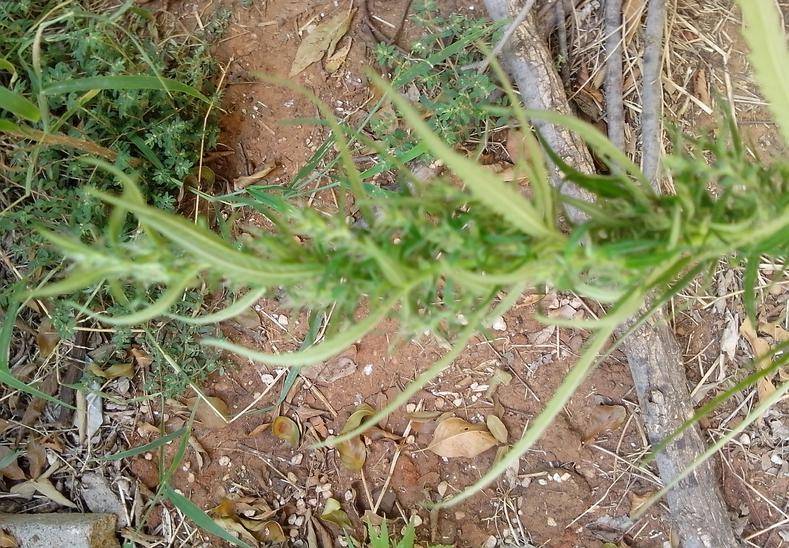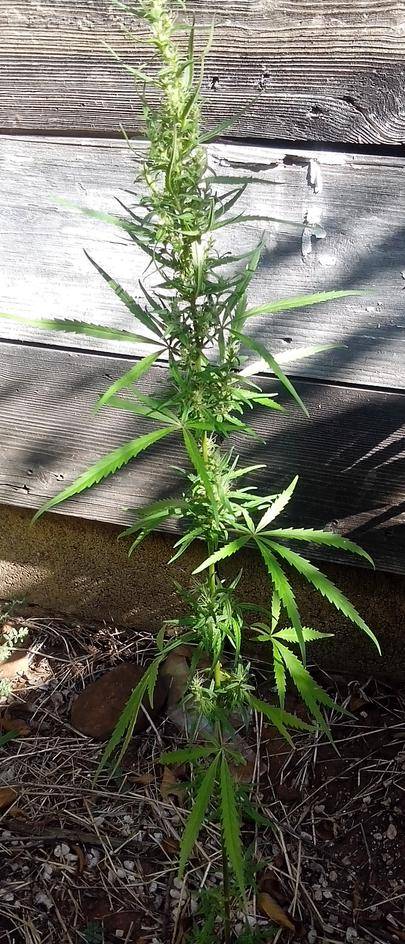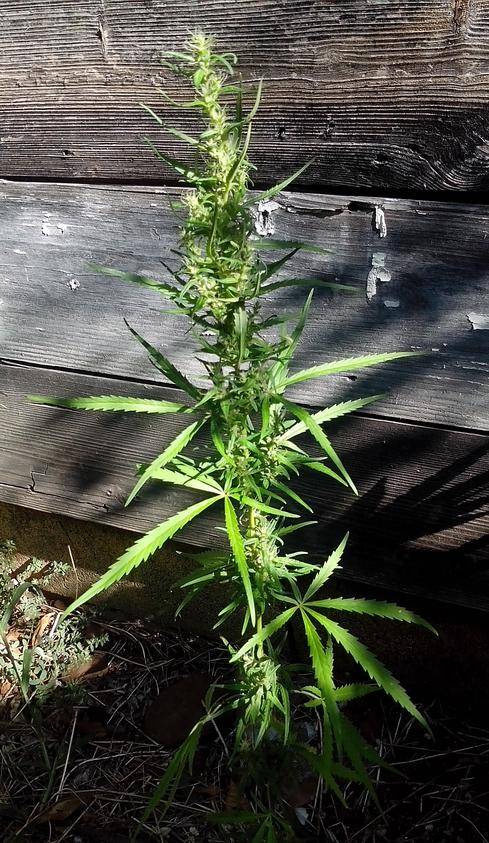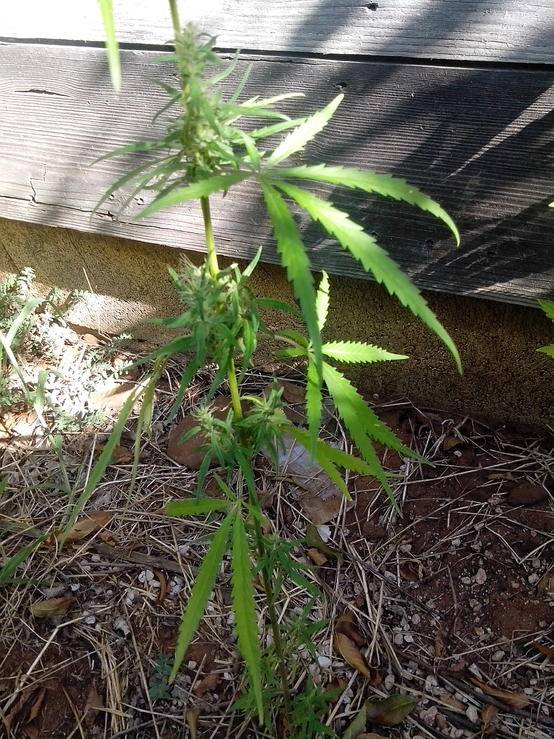-
Happy Birthday ICMag! Been 20 years since Gypsy Nirvana created the forum! We are celebrating with a 4/20 Giveaway and by launching a new Patreon tier called "420club". You can read more here.
-
Important notice: ICMag's T.O.U. has been updated. Please review it here. For your convenience, it is also available in the main forum menu, under 'Quick Links"!
You are using an out of date browser. It may not display this or other websites correctly.
You should upgrade or use an alternative browser.
You should upgrade or use an alternative browser.
Pure Thai Sativas
- Thread starter Samson4
- Start date
Next is the thai82 female I have been documenting.
She is very resinous now, however, all hairs are still white except the pollinated pistils.
Her smell, oh man how sweet she is. Sickly sweet, floral hash. That's the best I can think of. Really spacious buds. Some buds are singles calyxes separated by about 2 mm.
Her resin further backs my theory that she was a farmed line.




She is very resinous now, however, all hairs are still white except the pollinated pistils.
Her smell, oh man how sweet she is. Sickly sweet, floral hash. That's the best I can think of. Really spacious buds. Some buds are singles calyxes separated by about 2 mm.
Her resin further backs my theory that she was a farmed line.
T
tropicannayeah
Her resin further backs my theory that she was a farmed line.
Has anyone seen any wild plants (ganja that grows years after year without man's assistance) in Thailand? I haven't nor heard of any...if that's the case then all Thais would be "farmed" or cultivated.
and while the best examples of Thais are some of the best in the world, many plants from the same handful of seeds often have lots of variation in my experience and will have low to medium potency with a type of high or have other factors that are less than desirable , for example lots of male flowers on females.....so no plant is great until fully matured and smoke tested, let's hope this one has excellent effects.
Has anyone seen any wild plants (ganja that grows years after year without man's assistance) in Thailand? I haven't nor heard of any...if that's the case then all Thais would be "farmed" or cultivated.
and while the best examples of Thais are some of the best in the world, many plants from the same handful of seeds often have lots of variation in my experience and will have low to medium potency with a type of high or have other factors that are less than desirable , for example lots of male flowers on females.....so no plant is great until fully matured and smoke tested, let's hope this one has excellent effects.
Are you implying that no wild cannabis is growing in thailand? I am pretty sure that is incorrect. I have a line that was directly acquired in the wild. There is a reason that farmers have to keep adding outside genetics to speed harvest. It could be that nature selects the longer flowering genetics to reproduce the best, or; it could be that wild pollen finds it's way into their fields.
By a farmed line I mean it's a line that has been stably grown in an area while being guided by mans hand. This is different than a few farmers taking local seeds and adding outside genetics to speed harvest. I think what I should emphasize is the length of time the same line has been grown by the same farmers. Maybe a better phrase would be family line.
By a farmed line I mean it's a line that has been stably grown in an area while being guided by mans hand. This is different than a few farmers taking local seeds and adding outside genetics to speed harvest. I think what I should emphasize is the length of time the same line has been grown by the same farmers. Maybe a better phrase would be family line.
Actually there are only some feral semi-wild populations of cannabis in Central Asia and along the Himalayan foothills, Himachal Pradesh (North India) and all the Pamir range (where Central Asia meets South Asia). This plants are considered the putative genetic ancestors of the Narrow Leaf Drug type subspecies of Cannabis Indica that evolved mostly in the India (where the seedless ganja and bhang were part of their culture for thousands of years) and were dispersed all over the world by the humans.

From there, they travelled into Africa (through Zanzibar and Tanzania), the Caribbean and all over South East Asia, where they probably mixed themselves with the existing populations of intoxicating and never-devoided-of-THC Broad Leaf Hemp. This Broad Leaf Hemp came to the south from their place of origin somewhere around China (Cannabis Indica ssp. Chinensis), although it doesn't appear on the outdated map.
It's still possible to find many of this Broad Leaf Chinese cannabis nowadays in China, Korea, Japan and SE Asia (north of Thailand, Vietnam, Lao and Myanmar). Probably the Hmong tribes, who made a traditional and diverse use of cannabis, were the ones who contributed to its dispersal all over those places from China towards the south. Althought they probably become cross-pollinated there with the narrow leaf South Indian fine ganja strains during its early evolution, originating lots of different new cultivars that existed or still exist all over SE Asia.
Only those putative genetic ancestors from the Pamir and Himalayas should be considered truly wild or feral populations somehow, because since the men started to realize about their potential use (for food, drug, fiber), the plant become domesticated and its lifetime relationship with humans started. With the time, plants evolved favouring whichever part of them was used and preferred (seeds, fiber, resin, flowers).
So indeed all the cannabis populations around the world were taken and maintained by men (except those truly ancestral and the escaped feral populations, like the ditchweed in USA for example). The poor dispersion of the plant favoured its dependency on humans. It's a common mistake considering all those "landraces" wild populations of cannabis. It was geographic isolation and the men (together with soil and climatic characteristics of course) what made them to evolve to certain charateristics, not nature. Keep in mind that if it wasn't because humans, cannabis would probably have never left Central Asia. So more than wild landraces, they should be considered different regional domestic cultivars or ecotypes of Cannabis.
The old heirloom thai cultivars were indeed ancestral or heirloom domestic cannabis crops introduced and rudimentarily bred by the men and evolved from their Himalayan/Indian or Chinese original genetic ancestors, not wild thai landraces indeed, something that probably never existed. This should also work for any Mexican, Colombian, Jamaican, Ethiopian, Indonesian or whichever ancient traditional strain according to what we know in the present.
I highly recommend Hillig's latest papers (who studied cannabis' taxonomic evolution based on DNA) and Clarke's book for additional updated information on Cannabis evolution.
Vibes.

From there, they travelled into Africa (through Zanzibar and Tanzania), the Caribbean and all over South East Asia, where they probably mixed themselves with the existing populations of intoxicating and never-devoided-of-THC Broad Leaf Hemp. This Broad Leaf Hemp came to the south from their place of origin somewhere around China (Cannabis Indica ssp. Chinensis), although it doesn't appear on the outdated map.
It's still possible to find many of this Broad Leaf Chinese cannabis nowadays in China, Korea, Japan and SE Asia (north of Thailand, Vietnam, Lao and Myanmar). Probably the Hmong tribes, who made a traditional and diverse use of cannabis, were the ones who contributed to its dispersal all over those places from China towards the south. Althought they probably become cross-pollinated there with the narrow leaf South Indian fine ganja strains during its early evolution, originating lots of different new cultivars that existed or still exist all over SE Asia.
Only those putative genetic ancestors from the Pamir and Himalayas should be considered truly wild or feral populations somehow, because since the men started to realize about their potential use (for food, drug, fiber), the plant become domesticated and its lifetime relationship with humans started. With the time, plants evolved favouring whichever part of them was used and preferred (seeds, fiber, resin, flowers).
So indeed all the cannabis populations around the world were taken and maintained by men (except those truly ancestral and the escaped feral populations, like the ditchweed in USA for example). The poor dispersion of the plant favoured its dependency on humans. It's a common mistake considering all those "landraces" wild populations of cannabis. It was geographic isolation and the men (together with soil and climatic characteristics of course) what made them to evolve to certain charateristics, not nature. Keep in mind that if it wasn't because humans, cannabis would probably have never left Central Asia. So more than wild landraces, they should be considered different regional domestic cultivars or ecotypes of Cannabis.
The old heirloom thai cultivars were indeed ancestral or heirloom domestic cannabis crops introduced and rudimentarily bred by the men and evolved from their Himalayan/Indian or Chinese original genetic ancestors, not wild thai landraces indeed, something that probably never existed. This should also work for any Mexican, Colombian, Jamaican, Ethiopian, Indonesian or whichever ancient traditional strain according to what we know in the present.
I highly recommend Hillig's latest papers (who studied cannabis' taxonomic evolution based on DNA) and Clarke's book for additional updated information on Cannabis evolution.
Vibes.
Last edited:
Thanks Mustafunk! Love to see your maps on cannabis history!
WOW!
Keep in mind that if it wasn't because humans, cannabis would probably have never left Central Asia.
WOW!
Excellent read my friend. I do have a few points I'd like to make.
There are more escaped populations of cannabis in south asia than you make it sound. They are also older than what's found in the US, not that I need to tell you that. Also, we are responsible for globalization of cannabis, that's well understood. However, pollen and herbivores cannot be neglected in understanding the nature and acclimatization of geographical locations. We carried it someplace, and like a weed, it naturalizes.
This part was one of the main problems I had with Hillig. Some of their tested plant material had to be fresh, which meant being grown artificially. If I remember correctly; they did there experimental grows somewhere way north of the equator. Which would effect cannabinoid profiles; which he used as a classification. If I am remembering correctly, it is used as a man point of the study.
The biggest deterrent for me was of the age of the studies. His work is simply too young. I only wish the collections were made in the early 1900'S.
i do not discredit the studies, I just don't regard their work as complete and conclusive.
So indeed all the cannabis populations around the world were taken and maintained by men (except those truly ancestral and the escaped feral populations, like the ditchweed in USA for example).
Vibes.
There are more escaped populations of cannabis in south asia than you make it sound. They are also older than what's found in the US, not that I need to tell you that. Also, we are responsible for globalization of cannabis, that's well understood. However, pollen and herbivores cannot be neglected in understanding the nature and acclimatization of geographical locations. We carried it someplace, and like a weed, it naturalizes.
It was geographic isolation and the men (together with soil and climatic characteristics of course) what made them to evolve to certain charateristics, not nature. Keep in mind that if it wasn't because humans, cannabis would probably have never left Central Asia. So more than wild landraces, they should be considered different regional domestic cultivars or ecotypes of Cannabis.
This part was one of the main problems I had with Hillig. Some of their tested plant material had to be fresh, which meant being grown artificially. If I remember correctly; they did there experimental grows somewhere way north of the equator. Which would effect cannabinoid profiles; which he used as a classification. If I am remembering correctly, it is used as a man point of the study.
The biggest deterrent for me was of the age of the studies. His work is simply too young. I only wish the collections were made in the early 1900'S.
i do not discredit the studies, I just don't regard their work as complete and conclusive.
Are you implying that no wild cannabis is growing in thailand? I am pretty sure that is incorrect. I have a line that was directly acquired in the wild.
The same here only mine was acquired from the wild not in the wild .
The paper I referred to is "Genetic Evidence for Speciation in Cannabis" and not "A chemotaxonomic analysis of cannabinoid variation in Cannabis", where it was the genetic information and not the cannabinoid profiles what has been researched, genes won't change so I guess the research was quite conclusive in my opinion. The map was taken from that paper too.
Abstract:
That was really the reseach that changed it all in my opinion, or at least, reinforced what other authors and even some breeders and enthusiasts were already suggesting by studying the ethnobotany of Cannabis. For example we know that the word "Ganja" and "Bhang" originated in the India, guess why you can find those words and other derivatives from them being used too around Africa, later clay pipes found in Tanzania confirmed those theories on the origins of ganja smoking in Africa. Growers observed as well how the strains in northern Thailand or Vietnam have that "indica" look (Chinensis actually) as opposed to the Southern strains. While those strains and others like old Jamaicans and Zamal strains look a lot like traditional South Indian ganja strains, there are too many coincidences that point in the same direction to omit them in my opinion.
Anyway I'm sure the scientists will keep studying Cannabis and helping us to understand its evolution.

Abstract:
Sample populations of 157 Cannabis accessions of diverse geographic origin were surveyed for allozyme variation at 17 gene loci. The frequencies of 52 alleles were subjected to principal components analysis. A scatter plot revealed two major groups of accessions. The sativa gene pool includes fiber/seed landraces from Europe, Asia Minor, and Central Asia, and ruderal populations from Eastern Europe. The indica gene pool includes fiber/seed landraces from eastern Asia, narrow-leafleted drug strains from southern Asia, Africa, and Latin America, wide-leafleted drug strains from Afghanistan and Pakistan, and feral populations from India and Nepal. A third putative gene pool includes ruderal populations from Central Asia. None of the previous taxonomic concepts that were tested adequately circumscribe the sativa and indica gene pools. A polytypic concept of Cannabis is proposed, which recognizes three species, C. sativa, C. indica and C. ruderalis, and seven putative taxa.
That was really the reseach that changed it all in my opinion, or at least, reinforced what other authors and even some breeders and enthusiasts were already suggesting by studying the ethnobotany of Cannabis. For example we know that the word "Ganja" and "Bhang" originated in the India, guess why you can find those words and other derivatives from them being used too around Africa, later clay pipes found in Tanzania confirmed those theories on the origins of ganja smoking in Africa. Growers observed as well how the strains in northern Thailand or Vietnam have that "indica" look (Chinensis actually) as opposed to the Southern strains. While those strains and others like old Jamaicans and Zamal strains look a lot like traditional South Indian ganja strains, there are too many coincidences that point in the same direction to omit them in my opinion.
Anyway I'm sure the scientists will keep studying Cannabis and helping us to understand its evolution.
Last edited:
The old heirloom thai cultivars were indeed ancestral or heirloom domestic cannabis crops introduced and rudimentarily bred by the men and evolved from their Himalayan/Indian or Chinese original genetic ancestors, not wild thai landraces indeed, something that probably never existed. This should also work for any Mexican, Colombian, Jamaican, Ethiopian, Indonesian or whichever ancient traditional strain according to what we know in the present.
It is always presumed that man was less sophisticated hundreds, thousands, or 10 thousand years ago, until we repeatedly find out that they actually were highly skilled and sophisticated. We don't give the shamans of S.E. Asia, Africa, S. America and Mexico enough credit for developing heirloom strains that I consider the pinnacles of Cannabis breeding that are yet unsurpassed by "modern" breeding, in my opinion. These strains are still highly sought after by seed companies as the basis for the creation of "new" strains for their commercial offerings. These are not "landrace" strains, they have been molded by the human hand for a very long time, as long or longer than any other plant has been.
ThaiBliss
It is always presumed that man was less sophisticated hundreds, thousands, or 10 thousand years ago, until we repeatedly find out that they actually were highly skilled and sophisticated.
Indeed... even hundreds of years ago, when the first sinsemilla uses in Bengal in the India (Bengal=Bhang Land) were recorded, they had the poddars or ganja-doctors, who would visit the field many times as the plants matured in order to remove the males and intersex plants that could lower the quality of the crop.
When the flowers form, an important personage arrives on the scene: the poddar, or parakdar, the “ganja doctor”. His job is to chop down all of the male plants in the field
Excerpt from "REPORT ON THE CULTIVATION AND USE OF GÁNJÁ (Calcutta 1893)".
In the beginning of January the hemp begins to flower, and from this time onward the cultivator is on the outlook for those abnormal male flowers on his female plants which the poddar could not possibly have foretold. Harvesting begins to be general about the middle of February and is all over by the middle of March.
The discovery that the earlier in the season the male plants were rejected, the more resin the others formed, would naturally follow. And finally, the practice of throwing out the males because they are in themselves worthless would reach the stage which it has attained in the gánjá mahals, where their discovery even before they have flowered, and their complete elimination because of their effect on the other sex, has become an art.
I can definitely imagine why the Indian ganja was one of the finest that ever existed and how they spreaded their knowledge of the plant worldwide.
T
tropicannayeah
Are you implying that no wild cannabis is growing in thailand? I am pretty sure that is incorrect. I have a line that was directly acquired in the wild.
I'm not implying, I'm asking..which is different from what you are doing which is believing if that is what you mean by "pretty sure".
The same here only mine was acquired from the wild not in the wild
"in the wild" or "from the wild" Please explain what that means? ...anyway, has anyone actually seen any plants in Thailand that a human didn't plant?
Wild ganja is common in many parts of Pakistan, India and Nepal.....there's no reason why the same doesn't occur in Thailand or Laos, maybe there is some growing by itself on some creek banks, it's just that I never saw or heard of it and I spent most of the 80's there.
I'm not implying, I'm asking..which is different from what you are doing which is believing if that is what you mean by "pretty sure".
The same here only mine was acquired from the wild not in the wild
"in the wild" or "from the wild" Please explain what that means? ...anyway, has anyone actually seen any plants in Thailand that a human didn't plant?
Wild ganja is common in many parts of Pakistan, India and Nepal.....there's no reason why the same doesn't occur in Thailand or Laos, maybe there is some growing by itself on some creek banks, it's just that I never saw or heard of it and I spent most of the 80's there.
Goatstroker
Member
So indeed all the cannabis populations around the world were taken and maintained by men (except those truly ancestral and the escaped feral populations, like the ditchweed in USA for example).
Ditchweed in the US was also taken and maintained by man for the war effort, no?
No the ditchweed is escapees from the war effort. Before the big hemp farms there was no feral cannabis in the US.
Goatstroker
Member
No the ditchweed is escapees from the war effort. Before the big hemp farms there was no feral cannabis in the US.
Well I guess that was my understanding too.
Okay, took a second for all this to work in my brain. I'm good now, carry on ...
No the ditchweed is escapees from the war effort. Before the big hemp farms there was no feral cannabis in the US.
There has been feral hemp since colonial times without a doubt. Lot's more hemp grown per capita then than now
 ....maybe more Ganja now though
....maybe more Ganja now though 
I asked if you were implying not stating that you were implying; don't get defensive. I'm not believing I told you I have proof of plants collected from populations not sustained by man. Your last post contributed nothing but animosity to the thread.Are you implying that no wild cannabis is growing in thailand? I am pretty sure that is incorrect. I have a line that was directly acquired in the wild.
I'm not implying, I'm asking..which is different from whatyou are doing which is believing if that is what you mean by "pretty sure".
The same here only mine was acquired from the wild not in the wild
"in the wild" or "from the wild" Please explain what that means? ...anyway, has anyone actually seen any plants in Thailand that a human didn't plant?
Wild ganja is common in many parts of Pakistan, India and Nepal.....there's no reason why the same doesn't occur in Thailand or Laos, maybe there is some growing by itself on some creek banks, it's just that I never saw or heard of it and I spent most of the 80's there.


